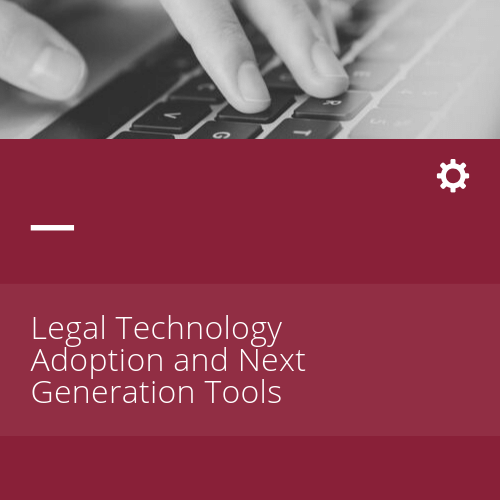Adopting Legal Technology: Legal Billing System
The billing process can be a challenge for many, if not most, firms. Finding a billing system that simplifies the process - from start to finish - not only saves time but increases accuracy. It all starts with understanding current systems, finding solutions that make the process simple for the firm and clients, all at a reasonable price.
Identify Your Firm’s Needs
To find the right billing system for the law firm, ask questions like:
- What are our current processes for managing billing?
- What are the pain points in the current system?
- Are there aspects of the process that are time consuming? If so, what are they?
- How much time does the billing process take from the firm, from time and expense tracking through to invoice payment?
Understanding the current process, existing challenges, and time requirements helps the firm focus on the precise aspects with room for improvement. Remember to consider the payment process for clients and reconciliation.
Choose the Right Legal Billing System
The best legal billing system maximizes the benefits for clients and the firm. Compare the client functionality with the functionalities it provides the firm. Here are few features that legal billing software can offer:
-
Time Tracking: Always an opportunity area, look for software that supports the way the firm likes to work. Whether manual entry, using responsive time trackers, or having assistants enter the information, find the software that supports the firm.
-
Customizable Billing Options: Offers multiple types of billing options such as hourly, flat fee, installment, trust, contingency, LEDES, and more. Sure, the firm may not need them now but may need them down the road.
-
Create Invoices: Whether creating individual invoices for specific matters on demand, an end-of-the-month batch invoice approach, or supporting client level invoices that include multiple matters, be sure to look for software that supports clients requrements.
-
Secure Online Payment: Gives clients immediate access to securely view and pay their invoices through the client portal. Some programs, like SimpleLaw, provide clients with the ability to create a custom link if their firm doesn't use one of the integrated options.
- Integration: Built-in integrations with programs like Confido Legal, LawPay, and Quickbooks that are available to all users.
A billing system optimizes the time a firm spends tracking time and expenses, creating invoices, and collecting payments is key. It also gives clients a way to securely pay their legal fees right through the platform. Simple.
Get Buy-In from Key Stakeholders
No matter the usefulness of legal software, its' adoption will fail if no one supports it. This is especially true for legal billing systems. Here are a few steps to follow in order to secure those key buy-ins:
-
Involve employees early: Engage key staff members—attorneys, paralegals, admins— in demos and discussions. Let them ask questions and raise concerns.
-
Highlight benefits to everyone: Show clients how they'll benefit from using the legal billing software. Explain how clients also benefit, further supporting the firm.
-
Nominate a project lead: Choose someone from the firm to lead the charge, preferably someone who is familiar with the technology and can rally both employees and clients behind their efforts.
By ensuring support from key players in the firm early on, the odds of successfully adopting legal billing system software will greatly increase.
Develop a Clear Implementation Plan
Having chosen the best legal billing system and gotten key buy-ins, the next step is to create a system of adoption that will guarantee success.
A good implementation plan should include:
- A Defined Timeline: Review the current billing cycle. Identify the best timing to make the move. Some firms begin using the new billing software to coincide with a monthly cut off. Others choose to start using the new system with new matters. Consider the firms current billing process and set your plan.
- Customize Billing Options: Tailor the billing system to best suit the needs of the firm and its clients. Does the firm need multiple types of accounting treatments? What about flat fee or hourly billing? Having the software preset to meet the needs of the firm streamlines the process.
- Provide training : Offer hands-on training for every aspect of the billing system. Show employees how they add time and expenses. Make sure the person who creates invoices and tracks payments has the information they need to complete the process. Show clients how they can pay invoices through the firm's portal or via the custom link on their invoice.
Integrate the System into Daily Operations
Ensuring the successful adoption of a legal billing system means incorporating it into the daily operations of the firm.
Here are some steps to help streamline the integration process:
-
Introduce to clients: Provide clients with an introduction to the billing system, showcasing how it can be utilized.
-
Encourage use: Have employees utilize the program when creating and collecting legal fees and invoices from clients.
-
Built-in training: Automatically introduce new hires to the billing system as part of their on boarding process. Using it from day one breed familiarity and confidence with employees.
-
Do away with the old: Emphasize that this billing system will be the new standard. It will be the only way for employees to create and request legal fees and for clients to pay them.
Embedding the system into the firm's operations and culture creates familiarity, consistency, transparency, and efficiency in a way that elevate productivity and efficiency.
Monitor and Optimize Usage
Even after fully rolling out the new billing system, it still requires time to determine if the adoption is successful. Regularly monitor its use by both employees and clients to discern how well it benefits both parties.
Ask questions like:
-
How much time have employees spent on time and expense tracking, invoice creation and fee collection since adopting the new system?
-
Are clients having having a hard time paying invoices? Have payments been received faster?
- How well does the new billing system balance the needs of employees and clients with the financial realities of the firm?
Be sure to collect feedback from users. Continue to refine the ways employees and clients utilize the billing system. Staying updated on new program features also helps because many legal tech platforms release updates that can further streamline operations and add new automation capabilities. After all, software isn’t static-so why should your firm's operational procedures be?
Conclusion
Adopting a new legal billing system can be tricky. Billing and payment are the literal lifeblood of the firm. However, if done well, adopting an efficient legal billing system can:
- Greatly decrease time and effort spent on creating, collecting, and organizing legal payments.
- Optimize bill payments by providing an easily accessible avenue for clients to do so.
- Elevate transparency and client trust by offering chances for customization options that cater to each client's needs.
By adopting legal technology, including a legal billing system, firms can improve accuracy, client satisfaction, and cash flow. With a one-stop-shop for all things billing, firms can eliminate one of the biggest sources of delays and busy work in their operations.
SimpleLaw makes it easy with an all-in-one case management solution designed for law firms that want reliable and time-saving legal billing systems—all without the learning curve.
👉 Want to see how SimpleLaw can transform your practice? [Schedule a demo today.]


